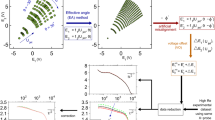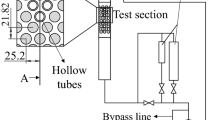Abstract
Experiments are conducted to evaluate the ability of various schemes to correct for pressure distortion caused by a finite tubing length between the pressure tap and the transducer. This study focuses on relatively short tubes, such as those encountered in multi-hole probes. Experimentally determined dynamic response is compared to the analytical model of Berg and Tijdeman with and without the Wiener filter. Bench-top experiments show that, for pneumatic systems with relatively short tubes, the addition of the Wiener filter carries no advantage over the Berg and Tijdeman model. The true advantage of the Wiener deconvolution method is observed for pressure tubes longer than ∼150 mm. Finally, the mean axial velocity and three Reynolds stress distributions from three correction schemes are compared to particle image velocimetry (PIV) results in a shear flow experiment. The statistical results ascertain the advantage of the Berg and Tijdeman and the Wiener deconvolution method over the generally noise-dominated inverse transfer function method.








Similar content being viewed by others
Abbreviations
- A c :
-
Cross-sectional area of tube (cm2)
- c :
-
Sonic velocity (m/s)
- D :
-
Tube diameter (cm)
- f :
-
Cyclic frequency (Hz)
- G :
-
Wiener deconvolution function
- G 00 :
-
Power spectrum from p 0
- G 0L :
-
Cross-spectra from p 0 and p L
- H :
-
Irwin et al. experimental deconvolution function
- ITF :
-
Inverse transfer function (H)
- L :
-
Tube length (cm)
- N :
-
Frequency-domain noise (Pa/s)
- P :
-
Fourier-transformed pressure (Pa· s)
- p :
-
Time-domain pressure (Pa)
- p 0 :
-
Input (surface) pressure (Pa)
- p static :
-
Static pressure (Pa)
- p total :
-
Total pressure (Pa)
- P 00 :
-
Variance of surface pressure (Pa2)
- p L :
-
Sensed transducer pressure (Pa)
- SRM :
-
System response model of Berg and Tijdeman
- S/N :
-
Signal-to-noise ratio
- t :
-
Time (s)
- V :
-
Transducer volume (cm3)
- WF–SRM :
-
Wiener filtered system response model
- \(\Upgamma_p\) :
-
Wave propagation factor
- \(\Upupsilon\) :
-
Berg and Tijdeman deconvolution function
- w :
-
Angular frequency (rad/s)
- \(\hat{}\) :
-
Reconstructed signal
- * :
-
Complex conjugate
References
Anderson RC, Englund DR (1971) Liquid-filled pressure measuring systems; a method for determining frequency response. Tech. Rep. TN D-6603, NASA
Berg H, Tijdeman H (1965) Theoretical and experimental results for the dynamic response of pressure measuring systems. Tech. Rep. NLR-TR-F238, National Aerospace Laboratory, Amsterdam
Chen J, Haynes BS, Fletcher DF (2000) Cobra probe measurements of mean velocities, Reynolds stresses and higher-order velocity correlations in pipe flow. Exp Therm Fluid Sci 21:206–217
Everett KN, Gerner AA, Durston DA (1983) Seven-hole cone probes for high angle flow measurement: theory and calibration. AIAA J 21:992–998
Hooper JD, Musgrove AR (1997) Reynolds stress, mean velocity, and dynamic static pressure measurement by a four-hole pressure probe. Exp Therm Fluid Sci 15:375–383
Hougen JO, Martin OR, Walsh RA (1963) Dynamics of pneumatic transmission lines. Control Eng 10(3):114–117
Iberall AS (1950) Attenuation of oscillatory pressures in instrument lines. J Res Natl Bureau Stand, vol 45, pp 85–108
Irwin HPAH, Cooper KR, Girard R (1979) Correction of distortion effects caused by tubing systems in measurements of fluctuating pressures. J Ind Aerodyn 5:93–107
Kobayashi H, Leger T, Wolff JM (1998) Experimental and theoretical frequency response of pressure transducers for high speed turbomachiner. In: 34th AIAA/ASME/SAE/ASEE joint propulsion meeting, AIAA Paper 98-3745
Lavoie P, Avallone G, De Gregorio F, Romano GP, Antonia RA (2007) Spatial resolution of PIV for the measurement of turbulence. Exp Fluids 43:39–51
Matsunaga S, Ishibashi H, Nishi M (1980) Measurement of instantaneous pressure and velocity in nonsteady three-dimensional water flow by means of a combined five-hole probe. Trans ASME J Fluid Eng 102:196–202
Naughton JW, Cattafesta LN, Settles GG (1993) Miniature, fast-response five-hole conical probe for supersonic flow field measurements. AIAA J 31(3):453–458
Pao YH (1965) Structure of turbulent velocity and scalar fields at large wavenumbers. Phys Fluids 8(6):1063–1975
Schneider GM, Hooper JD, Musgrove AR, Nathan GJ, Luxton RE (1997) Velocity and Reynolds stresses in a precessing jet flow. Exp Fluids 22:489–495
Strike JA, Hind MD, Saini MS, Naughton JW, Wilson MD, Whitmore SA (2010) Unsteady surface pressure reconstruction on an oscillating airfoil using the wiener deconvolution method. In: 27th AIAA Aerodynamic measurement technology and ground testing conference, Chicago, Illinois, AIAA 2010-4799
Treaster AL, Yocum AM (1979) The calibration and application of five-hole probes. In: ISA Transactions, vol 18, pp 23–34
Whitmore SA, Wilson MD (2011) Wiener deconvolution for reconstruction of pneumatically-attenuated pressure signals. AIAA J 49(5):890–897
Wyngaard JC (1968) Measurement of small-scale turbulence with hot wires. J Sci Instr 1(2):1105–1108
Zilliac GG (1993) Modelling, calibration, and error analysis of seven-hole pressure probes. Exp Fluids 14:104–120
Author information
Authors and Affiliations
Corresponding author
Rights and permissions
About this article
Cite this article
Semaan, R., Scholz, P. Pressure correction schemes and the use of the Wiener deconvolution method in pneumatic systems with short tubes. Exp Fluids 53, 829–837 (2012). https://doi.org/10.1007/s00348-012-1332-2
Received:
Revised:
Accepted:
Published:
Issue Date:
DOI: https://doi.org/10.1007/s00348-012-1332-2




